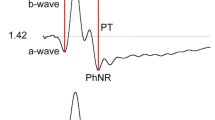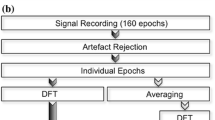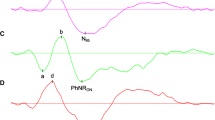Abstract
The basis of the multifocal/electroretinogram is the use of a decimated m-sequence for simultaneous and independent stimulation of many areas of the visual pathway. The purpose of this study was to investigate the effects of cross-contamination from higher orders of the response. A series of primitive polynomials were found by construction of finite fields. The first-order ERG response was formed by cross-correlation of m-sequence with the physiological response. A second-order response was formed by investigation of particular flash sequences of the stimulation sequence and cross-correlation of a second-order m-sequence with the physiological response. Zech logarithms were used to identify cross-contamination between the various first and second-order sequences. Tables of good and bad primitive polynomials were constructed for degrees 12–16, and the effects of window length and decimation length were examined. When the sequence was decimated into 128 areas, and a window of length 16 was examined, cross-contamination occurred in all sequences generated from primitive polynomials of degree less than or equal to 12, but in only 26% of degree 14, and 5.6% of degree 16. A photodiode (artificial eye) was used in an experiment to construct trace arrays showing responses from 61 individual areas. Additional waveforms were present on the trace array when the experiment was carried out with a bad primitive polynomial. The use of finite field theory to generate primitive polynomials and Zech logarithm analysis allowed prediction of which primitive polynomials were suitable for m-sequence generation for multifocal electroretinography. Practical investigations supported the theoretical analysis. This has important implications for developers of multifocal electrophysiology systems.
Similar content being viewed by others
References
Colbourn, C. J., andDinitz, J. H. (1996): ‘The CRC handbook of combinatorical designs’ (CRC Press)
Carr, R. E., andSiegel, I. M. (1990): ‘Electrodiagnostic testing of the visual system: a clinical guide’, (F. A. Davies Company, 1990)
Davies, W. D. T. (1970): ‘System identification for self-adaptive control’, (Wiley, 1970)
Fricker, S. J., andSanders, J. J. (1974): ‘A new method of cone electroretinography: the rapid random flash response’,Investig. Ophthalmol.,14, pp. 131–137
Horowitz, P., andHill, W. (1989): ‘The art of electronics’, 2nd edn (Cambridge University Press, 1989)
Lidl, R., andNiederreiter, H. (1994): ‘Introduction to finite fields and their applications’, 2nd edn (Cambridge University Press, 1994)
McEliece, R. J. (1987): ‘Finite fields for computer scientists and engineers’, (Klumer Academic Publishers, 1987)
MacWilliams, F. J., andSloane, N. J. A. (1976): ‘The theory of error correcting codes’ (North-Holland, 1976)
MacWilliams, F. J., andSloane, N. J. A. (1977): ‘Pseudo-random sequences and arrays’,Proc. IEEE,64, pp. 1715–1729
Schroeder, M. R. (1986): ‘Number theory in science and communication’, 2nd enlarged edn (Springer-Verlag, 1986)
Srebro, R., andWright, W. W. (1998): ‘Visually evoked potentials to pseudorandom binary sequence stimulation. Preliminary clinical trials’,Arch Ophthalmol.,2, pp. 296–298
Sutter, E. E., andTran, D. (1992): ‘The field topography of ERG components in man-1. The photopic luminance response’,Vis. Res.,32, pp. 433–446
Author information
Authors and Affiliations
Corresponding author
Rights and permissions
About this article
Cite this article
Ireland, J.M., Keating, D., Hoggar, S.G. et al. Identification of appropriate primitive polynomials to avoid cross-contamination in multifocal electroretinogram responses. Med. Biol. Eng. Comput. 40, 471–478 (2002). https://doi.org/10.1007/BF02345081
Received:
Accepted:
Issue Date:
DOI: https://doi.org/10.1007/BF02345081




